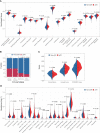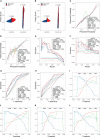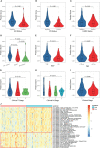Machine learning models based on immunological genes to predict the response to neoadjuvant therapy in breast cancer patients
- PMID: 35935976
- PMCID: PMC9352856
- DOI: 10.3389/fimmu.2022.948601
Machine learning models based on immunological genes to predict the response to neoadjuvant therapy in breast cancer patients
Abstract
Breast cancer (BC) is the most common malignancy worldwide and neoadjuvant therapy (NAT) plays an important role in the treatment of patients with early BC. However, only a subset of BC patients can achieve pathological complete response (pCR) and benefit from NAT. It is therefore necessary to predict the responses to NAT. Although many models to predict the response to NAT based on gene expression determined by the microarray platform have been proposed, their applications in clinical practice are limited due to the data normalization methods during model building and the disadvantages of the microarray platform compared with the RNA-seq platform. In this study, we first reconfirmed the correlation between immune profiles and pCR in an RNA-seq dataset. Then, we employed multiple machine learning algorithms and a model stacking strategy to build an immunological gene based model (Ipredictor model) and an immunological gene and receptor status based model ICpredictor model) in the RNA-seq dataset. The areas under the receiver operator characteristic curves for the Ipredictor model and ICpredictor models were 0.745 and 0.769 in an independent external test set based on the RNA-seq platform, and were 0.716 and 0.752 in another independent external test set based on the microarray platform. Furthermore, we found that the predictive score of the Ipredictor model was correlated with immune microenvironment and genomic aberration markers. These results demonstrated that the models can accurately predict the response to NAT for BC patients and will contribute to individualized therapy.
Keywords: breast cancer; immunological gene; machine learning; neoadjuvant therapy; pathological complete response.
Copyright © 2022 Chen, Hao, Qian, Lin, Pan and Han.
Conflict of interest statement
The authors declare that the research was conducted in the absence of any commercial or financial relationships that could be construed as a potential conflict of interest.
Figures





Similar articles
-
Multimodal diagnostic models and subtype analysis for neoadjuvant therapy in breast cancer.Front Immunol. 2025 Mar 18;16:1559200. doi: 10.3389/fimmu.2025.1559200. eCollection 2025. Front Immunol. 2025. PMID: 40170854 Free PMC article.
-
Machine learning on MRI radiomic features: identification of molecular subtype alteration in breast cancer after neoadjuvant therapy.Eur Radiol. 2023 Apr;33(4):2965-2974. doi: 10.1007/s00330-022-09264-7. Epub 2022 Nov 23. Eur Radiol. 2023. PMID: 36418622
-
Multivariate machine learning models for prediction of pathologic response to neoadjuvant therapy in breast cancer using MRI features: a study using an independent validation set.Breast Cancer Res Treat. 2019 Jan;173(2):455-463. doi: 10.1007/s10549-018-4990-9. Epub 2018 Oct 16. Breast Cancer Res Treat. 2019. PMID: 30328048 Free PMC article.
-
Proposing a novel molecular subtyping scheme for predicting distant recurrence-free survival in breast cancer post-neoadjuvant chemotherapy with close correlation to metabolism and senescence.Front Endocrinol (Lausanne). 2023 Oct 12;14:1265520. doi: 10.3389/fendo.2023.1265520. eCollection 2023. Front Endocrinol (Lausanne). 2023. PMID: 37900131 Free PMC article. Review.
-
Exploring the Potential Role of Circulating microRNAs as Biomarkers for Predicting Clinical Response to Neoadjuvant Therapy in Breast Cancer.Int J Mol Sci. 2023 Jun 10;24(12):9984. doi: 10.3390/ijms24129984. Int J Mol Sci. 2023. PMID: 37373139 Free PMC article. Review.
Cited by
-
Clinical prediction of pathological complete response in breast cancer: a machine learning study.BMC Cancer. 2025 May 23;25(1):933. doi: 10.1186/s12885-025-14335-1. BMC Cancer. 2025. PMID: 40410776 Free PMC article.
-
Investigating the effects of artificial intelligence on the personalization of breast cancer management: a systematic study.BMC Cancer. 2024 Jul 18;24(1):852. doi: 10.1186/s12885-024-12575-1. BMC Cancer. 2024. PMID: 39026174 Free PMC article.
-
Clinical significance of androgen receptor in unilateral invasive breast cancer in women.Eur J Med Res. 2025 Aug 23;30(1):793. doi: 10.1186/s40001-025-03072-7. Eur J Med Res. 2025. PMID: 40846987 Free PMC article.
-
MammOnc-DB, an integrative breast cancer data analysis platform for target discovery.Res Sq [Preprint]. 2024 Sep 26:rs.3.rs-4926362. doi: 10.21203/rs.3.rs-4926362/v1. Res Sq. 2024. Update in: NPJ Breast Cancer. 2025 Apr 18;11(1):35. doi: 10.1038/s41523-025-00750-x. PMID: 39399665 Free PMC article. Updated. Preprint.
-
The Expression Profiles of lncRNAs Are Associated with Neoadjuvant Chemotherapy Resistance in Locally Advanced, Luminal B-Type Breast Cancer.Int J Mol Sci. 2024 Jul 24;25(15):8077. doi: 10.3390/ijms25158077. Int J Mol Sci. 2024. PMID: 39125649 Free PMC article.
References
-
- Yau C, Osdoit M, van der Noordaa M, Shad S, Wei J, de Croze D, et al. Residual cancer burden after neoadjuvant chemotherapy and long-term survival outcomes in breast cancer: a multicentre pooled analysis of 5161 patients. Lancet Oncol (2022) 23:149–60. doi: 10.1016/S1470-2045(21)00589-1 - DOI - PMC - PubMed
-
- Pfob A, Sidey-Gibbons C, Rauch G, Thomas B, Schaefgen B, Kuemmel S, et al. Intelligent vacuum-assisted biopsy to identify breast cancer patients with pathologic complete response (ypT0 and ypN0) after neoadjuvant systemic treatment for omission of breast and axillary surgery. J Clin Oncol (2022) 40:1903–15. doi: 10.1200/JCO.21.02439 - DOI - PubMed
Publication types
MeSH terms
Substances
LinkOut - more resources
Full Text Sources
Medical
Molecular Biology Databases

